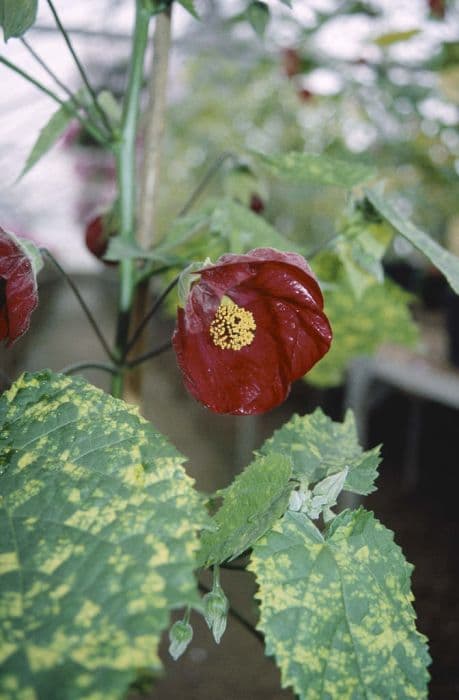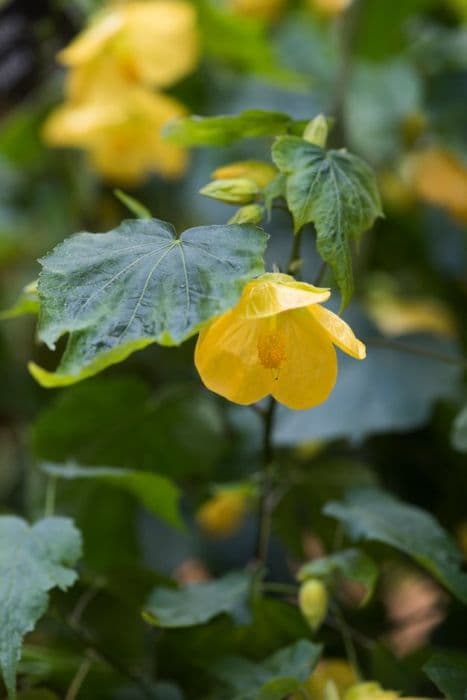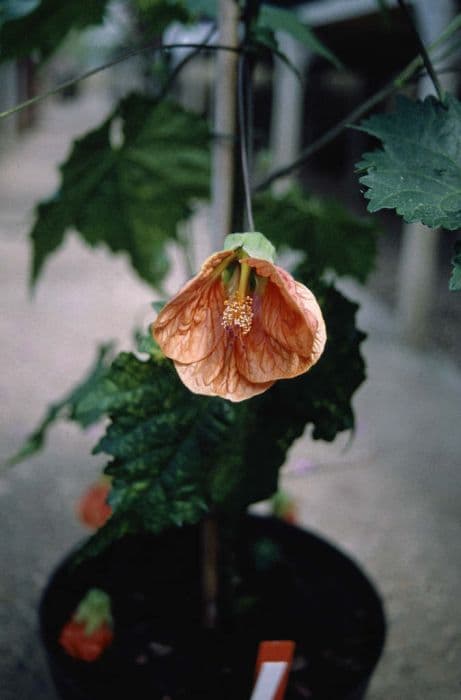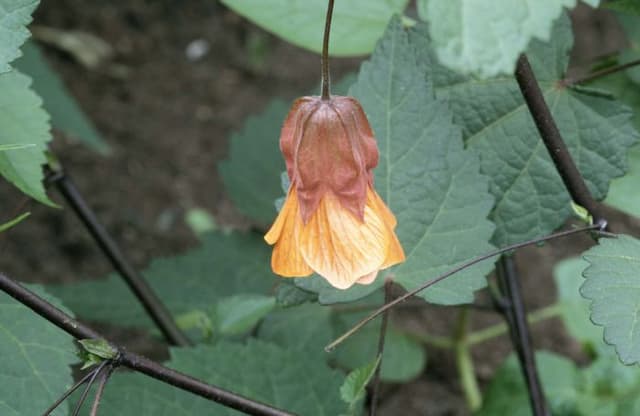Rose of Sharon Hibiscus sinosyriacus 'Ruby Glow'

ABOUT
The Hibiscus 'Ruby Glow' is adorned with eye-catching flowers that are characterized by their deep ruby-red color, adding a vibrant splash of color wherever they are planted. The blooms stand out with their large, trumpet-shaped appearance, enticing onlookers with their sizable, showy petals that can capture the gaze of any passerby. These flowers typically possess a velvety texture, giving them a luxurious feel and appearance. At the center of each flower is a pronounced and contrasting staminal column that often attracts pollinators, adding dynamism to the plant's appeal. Beyond the flowers, the plant sports broad, lush green leaves that provide a striking backdrop for the red blooms, enhancing their radiance. The foliage contributes to the plant’s overall lush and tropical look, reminiscent of the warm, sunny climates the hibiscus is commonly associated with. With its striking flowers and attractive foliage, the Hibiscus 'Ruby Glow' makes a standout addition to any garden or landscape, bringing with it a flair of exotic charm and a burst of rich color.
About this plant
 Names
NamesFamily
Malvaceae
Synonyms
Rose Of Sharon, Syrian Ketmia, Shrub Althea
Common names
Hibiscus sinosyriacus 'Ruby Glow'.
 Toxicity
ToxicityTo humans
Hibiscus is not commonly known to be toxic when touched or ingested. There might be individual cases of allergic reactions or sensitivity, but overall, hibiscus plants, including Hibiscus 'Ruby Glow', are considered non-toxic to humans. Therefore, typical ingestion of parts of the plant should not cause any symptoms of poisoning. However, as with any non-food plants, it is advisable to avoid ingesting them, and care should be taken around children who might be more sensitive or susceptible to putting plant parts in their mouth.
To pets
Hibiscus is generally recognized as non-toxic to pets, including both dogs and cats. The Hibiscus 'Ruby Glow' should not cause any severe symptoms of poisoning if ingested by pets. However, some pets might have a mild reaction to eating hibiscus, such as drooling, vomiting or diarrhea, primarily due to the novelty of the plant material rather than toxicity. It is always a good practice to monitor pets and prevent them from consuming plants that are not specifically intended for their consumption.
 Characteristics
CharacteristicsLife cycle
Perennials
Foliage type
Deciduous
Color of leaves
Green
Flower color
Red
Height
6-8 feet (1.8-2.4 meters)
Spread
4-6 feet (1.2-1.8 meters)
Plant type
Shrub
Hardiness zones
7
Native area
China Korea
Benefits
 General Benefits
General Benefits- Attracts Pollinators: The Ruby Glow hibiscus produces vibrant flowers that are attractive to bees, butterflies, and other beneficial pollinators.
- Landscape Beautification: With its richly colored blooms, this hibiscus variety adds visual interest and aesthetic appeal to gardens and landscapes.
- Ease of Care: Hibiscus sinosyriacus 'Ruby Glow' is relatively low-maintenance, requiring minimal care once established in the right conditions.
- Drought Tolerance: Once established, it has a certain degree of tolerance to dry conditions, requiring less frequent watering.
- Seasonal Interest: The plant provides seasonal blooms that enhance the garden's appeal during its flowering period.
- Privacy: When planted in groups or as a hedge, it can provide a natural privacy screen while adding decorative value.
- Adaptability: It can adapt to a range of soil types, although it prefers well-drained soils, making it suitable for various garden settings.
 Medical Properties
Medical PropertiesThis plant is not used for medical purposes.
 Air-purifying Qualities
Air-purifying QualitiesThis plant is not specifically known for air purifying qualities.
 Other Uses
Other Uses- Hibiscus sinosyriacus 'Ruby Glow', commonly known as Rose of Sharon, can be used to create a dense privacy hedge due to its bushy nature and rapid growth.
- The wood of Rose of Sharon is tough and can be used to make small wooden implements, such as handles for tools or garden stakes.
- The flowers of the Rose of Sharon are edible and can be used to add color and a mild flavor to salads or as garnishes on plates.
- Owing to its bright flowers, Rose of Sharon can be used in fabric dyeing to obtain natural dyes for coloring textiles.
- Due to its shape and beauty, Rose of Sharon can be trained into bonsai, offering an exotic element for collectors and hobbyists.
- The blooms of the Rose of Sharon can be used in making floral water or infusions for use in cosmetic products like natural perfumes or lotions.
- The Rose of Sharon attracts pollinators, including bees and butterflies, thereby supporting local ecosystems and benefiting gardens.
- Paper can be made from the fibers of the Rose of Sharon's bark, providing a very artisanal type of paper for crafts or even fine arts.
- The leaves of the Rose of Sharon can be used as a natural mulch to help retain soil moisture and suppress weeds in gardens.
- Artists can use the flowers of the Rose of Sharon as motifs or inspiration for paintings, textiles, or other art forms, thanks to their vibrant and show-stopping appearance.
Interesting Facts
 Feng Shui
Feng ShuiThe Rose of Sharon is not used in Feng Shui practice.
 Zodiac Sign Compitability
Zodiac Sign CompitabilityThe Rose of Sharon is not used in astrology practice.
 Plant Symbolism
Plant Symbolism- Delicate Beauty: Hibiscus is often associated with delicate and ephemeral beauty, as its blossoms are known for being both striking and short-lived.
- Femininity: The soft and varied colors of the hibiscus flowers symbolize feminine energy and beauty.
- Hospitality: In some cultures, hibiscus is used to welcome guests, representing warmth and cordiality.
- Exoticism: As a plant that is native to tropical and warm temperate regions, the hibiscus exemplifies the allure and mystery of exotic places.
- Carpe Diem: The brief lifespan of the hibiscus bloom serves as a reminder to live in the moment and seize the day.
 Water
WaterThe Rose of Sharon requires watering deeply, ensuring that the water reaches the plant's roots, rather than just wetting the surface. During the growing season, water the plant once a week with about 1 to 1.5 gallons of water, depending on weather conditions like heat and wind that may increase the need for water. If rainfall is adequate, additional watering may not be necessary. It's crucial to reduce watering in the fall to prepare the plant for winter. Always check the soil moisture by feeling it a few inches deep; if it feels dry, it's time to water again.
 Light
LightRose of Sharon thrives best in full sun conditions, meaning it requires at least 6 to 8 hours of direct sunlight each day to perform optimally. Place it in a spot where it can receive unfiltered sunlight for most of the day. However, the plant can tolerate partial shade, especially in regions with very hot summers, where some afternoon shade can prevent overheating.
 Temperature
TemperatureThe Rose of Sharon is hardy and can tolerate a wide range of temperatures. It can survive in temperatures as low as 20°F and high as 90°F, but it grows best in temperatures between 60°F and 80°F. Sudden frosts or extreme heat can damage the plant, so protection may be necessary if these conditions are expected.
 Pruning
PruningPrune the Rose of Sharon in late winter or early spring before new growth starts. Pruning helps to shape the plant, encourage bushier growth, and remove any dead or damaged branches. It should be done annually, but light pruning can be performed throughout the year as needed. The best time for heavy pruning is when the plant is dormant to minimize stress and maximize the upcoming season's bloom.
 Cleaning
CleaningAs needed
 Soil
SoilRose of Sharon benefits from a well-draining, loamy soil with good organic content. The ideal pH range for Rose of Sharon 'Ruby Glow' is slightly acidic to neutral (pH 6.0 to 7.5). A mix of two parts loam, one part peat moss, and one part perlite or sand is recommended to ensure proper drainage and aeration.
 Repotting
RepottingRose of Sharon 'Ruby Glow' typically does not require frequent repotting, as it is often grown as a large shrub or small tree outdoors. However, if grown in containers, repotting every 2-3 years, or when the plant becomes root-bound, is advised to refresh the soil and provide additional space for growth.
 Humidity & Misting
Humidity & MistingRose of Sharon prefers moderate humidity levels but is quite adaptable to different humidity conditions. Strive for around 50-60% relative humidity for optimal growth if growing indoors.
 Suitable locations
Suitable locationsIndoor
Ensure bright, indirect light and consistent watering.
Outdoor
Place in full sun, protect from strong winds.
Hardiness zone
5-9 USDA
 Life cycle
Life cycleThe life cycle of the Hibiscus sinosyriacus 'Ruby Glow', commonly known as Rose of Sharon 'Ruby Glow', begins with seed germination when temperatures become favorable in spring. Seedlings emerge and grow into young plants, developing characteristic three-lobed leaves and woody stems. As the shrub matures, it enters a stage of vegetative growth, where it focuses on leaf production and increasing its overall size. Upon reaching maturity, typically within a few years, 'Ruby Glow' begins its reproductive phase, producing deep ruby-red flowers with prominent stamens during late summer, attracting pollinators for sexual reproduction. After pollination, the flowers develop into seed pods, which eventually dry and release seeds in autumn, completing the cycle. Throughout its life, the plant undergoes periods of dormancy in winter, where growth ceases temporarily, resuming with warmer weather in spring.
 Propogation
PropogationPropogation time
Spring to early summer
Hibiscus sinosyriacus 'Ruby Glow', commonly known as Rose of Sharon, can be propagated through several methods, but the most popular is via stem cuttings. To propagate by cuttings, one should ideally take a 4 to 6-inch (10 to 15 cm) long stem from a healthy, mature plant during late spring or early summer. This stem should have several leaves but the lower leaves should be removed before planting. The base of the cutting is then dipped in rooting hormone to encourage root growth and planted in a well-draining potting mix. The cutting should be kept moist and in a warm spot with indirect light until roots have developed, which usually takes several weeks. Once the cuttings have rooted, they can be transplanted into the garden or larger pots for further growth.





![Abutilon [Yellow Trumpet]](/_next/image?url=https%3A%2F%2Fplants-admin.emdemapps.com%2Fimages%2Fplants%2F%2Fimages%2F604b5caa8b4fb.png&w=640&q=75)


